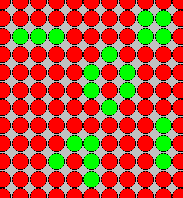
BIOLOGY 103
FALL, 2003
LAB 10


| BIOLOGY 103 |  |
This description, however, summarizes a more complex reality, involving many individual chemical reactions and different enzymes in particular spatial arrays in different bounded spaces. In this lab we will explore the implications of both the overall breakdown process involved in life and its complexity. To do this, we will look at CO2 production by yeast cells under a variety of conditions.
You will work in pairs to set up a series of experimental conditions. While these are evolving measurable CO2, you should write a set of predictions about which tubes should generate the most carbon dioxide and why. We will then look at the collected data and see to what extent it satisfies the various predictions.
We predict this because we think that glucose will break down faster than sucrose because sucrose is made up of glucose and fructose, therefore, 2 will produce more carbon dioxide than 1. Also, pyruvate breaks down into ethanol and carbon dioxide, therefore 4 will have more carbon dioxide than 1. Will said that fluoride was an inhibitor, so the more fluoride, the less carbon dioxide, so 6 will have more than 7. Without oxygen, the citric acid cycle cannot take place, therefore, the anaerobic yeast will produce the least carbon dioxide.
4. Active Yeast with Pyruvate (closer to end product)
2. Active Yeast with Glucose
3. Active Yeast with Sucrose (more complex)
6. Active Yeast with 0.01 NaF (inhibitor)
7. Active Yeast with 0.1 NaF (more inhibitor)
5. Lysed Yeast (uh, Will...?)
8. Anaerobic Yeast (produces smaller amount than aerobic)
1. Active Yeast with Water (nothing to break down)
Su-Lyn & Brittany
Test Tube #: 4, 7, 6, 2, 5, 3, 1.
We thought that an element is produced closer to the end of the process would yield more carbon dioxide when introduced to the yeast.
(All in accordance to the Spacial Arrangements and Metabolism)
We made these predictions based on a scale from 1-10
Tube 1 ( 9)
Tube 2 (6)
Tube 3 (4)
Tube 4 (8)
Tube 5 (7)
Tube 6 (9)
Tube 7 (10)
Net gas volume:
Test Tube 1: 0 cc/hr
Test Tube 2: 3 cc/hr
Test Tube 3: 4 cc/hr
Test Tube 4: 0 cc/hr
Test Tube 6:2.75 cc/hr
Test Tube 7: 0.5 cc/hr
Test Tube 8: 1.25 cc/hr
In looking at the results, we noticed that there was no sugar in either 1 or 4, therefore, no change in carbon dioxide is to be expected. 7 had the most fluoride, which is an inhibitor, so that makes sense. Since the concentration of fluoride in 6 isn't very large, the lack of oxygen in 8 served as more of an inhibitor. Since sucrose is made of glucose and fructose, and fructose will break down into glucose, the sucrose may be providing more volume of glucose, leading to 3 producing more carbon dioxide than 2. So our predictions were mainly incorrect, but we were correct that 2 and 3 would produce the most carbon dioxide.
We hypothesis the following order of gas reading, from most gas to least gas: (1=most, 7=least)
1. Active Yeast/Glucose/H2O (2)
2. Active Yeast/Sucrose/ H20 (3)
3. Lysed Yeast/Glucose/H2O (5)
4. Active Yeast/H2O (1)
5. Active Yeast/Pryruvate/H20 (4)
6. Active Yeast/Glucose/0.01 M NaF (6)
7. Active Yeast/Glucose/0.1 M NaF (7)
We made the following predictions based on our previous knowledge that flouride is an inhibitor of gas production. We also know that glucose promotes the production of gas. We also think that the active yeast will produce more gas b/c it is "active" versus the lysed yeast.
Our predictions:
1 is most carbon dioxide and 8 is least carbon dioxide:
1. tube 3
2. tube 2
3. tube 5
4. tube 7
5. tube 6
6. tube 8
7. tube 4
8. tube 1
We chose this order based on how long we thought the breakdown process would take place. If it took longer to break down, then we thought it would produce more carbon dioxide, but if it broke down quickly, then we thought it would produce less carbon dioxide.
CO2 yield predictions for yeast metabolic activity (least to most)
- 1. Active yeast + water
- 8. Anaerobic yeast + glucose + water
- 7. Active yeast + glucose + 0.1 NaF
- 6. Active yeast + glucose + 0.01 NaF
- 5. Lysed yeast + glucose + water
- 3. Active yeast + sucrose + water
- 2. Active yeast + glucose + water
- 4. Active yeast + pyruvate + water
1. Lysed Yeast/Glucose/H2O
2. Active Yeast/Sucrose/H2O
3. Active Yeast/Glucose/H2O
4. Active Yeast/Pyruvate/H2O
5. Anaerobic Yeast/Glucose/H2O
6. Active Yeast/Glucose/0.01M NaF
7. Active Yeast/Glucose/0.1M NaF
8. Active Yeast/H2O
We think that Lysed Yeast will produce the most gas in 45 minutes because the cell membrane is already broken down. We thought the next three would happen in that order because of the sequence of sucrose, glucose, and pyruvate in the breaking down process. If the reaction starts later in the process, less enzymes will be active. Starting from the back, we thought that active yeast and H2O would be last because there would be no enzymes active in the reaction. We thought that the mixtures wih NaF would be next to last because they seem to act as a block in the order of the reaction. Anaerobic Yeast is fifth because the reaction is stopping at the pyrubic acid phase.
Here are our predictions for the most CO2 to the least CO2.
Test Tube 1: 7
Test Tube 2: 2
Test Tube 3: 6
Test Tube 4: 1
Test Tube 5: 5
Test Tube 6: 4
Test Tube 7: 3
1: 1.75
2: 3.5
3: 2
4: 2
5: 2.5
6: 2
7: 2
8: .75
We predict that the tube which would have the greatest net change would be in tube number 4. The tubes that follow, from greatest net evaporation to least, would be:
3
2
1
5
8
6
7
Hypothesis: Amounts of CO2 will occur, from most to least, in this order:
#1) Pyruvate. Pyruvate is one of the products of glucose; it occurs later in the cycle. Because glucose breaks down into other substances in addition to pyruvate, 5 ml glucose would yield less than 5 ml pyruvate. So, using 5 ml pyruvate, which is implicated in later CO2 production, should produce more CO2 than any of the tests that use 5 ml of any kind of sugar (and hence less pyruvate) instead.
#2) Active Yeast and Glucose. Active yeast should be stronger than, and produce more CO2 than, lysed yeast (which is really dead already and so weaker) and anaerobic yeast (which doesn't perform the citric acid cycle and so can't produce CO2). Glucose, as a pure, simple reactant that is used in full and doesn't need converting from a more complex sugar or carb, should allow a lot of CO2 to be produced.
#3) Active Yeast and Sucrose. Should produce almost as much CO2 as #2 above, but not quite, because sucrose (a double sugar) must be broken down to form glucose (a simple, single sugar). This process of breaking down takes time and energy, so at any given point in time, this reaction will be less far along in its CO2 production than the reaction above, which uses pure glucose.
#4) Lysed Yeast and Glucose. Lysed yeast, since it is dead, won't be as potent. However, some of the enzymes should still be working, and some CO2 should still be produced.
#5) Active Yeast, Glucose, .01M NaF. NaF should inhibit the action of the enzyme which converts the glucose into other forms, thereby limiting CO2 production.
#6) Active Yeast, Glucose, .1M NaF. A higher concentration of NaF will have the same effect on CO2 production as in #5 above, but to a greater extent, because there is more of it to inhibit the enzyme action.
#7) Active Yeast, Water, No Glucose. Without glucose as the substrate/reactant, a lot less CO2 should be produced. However, Julia has observed that plain yeast mixed with water does produce bubbles of CO2, so we decided not to place this one last on the CO2 hierarchy.
#8) Anaerobic Yeast, Glucose. Anaerobic yeast cannot, without using oxygen, go through the Krebs / Citric Acid cycle, so it cannot produce CO2. According to this estimate, the anaerobic yeast should do whatever it can do without oxygen without producing ANY CO2. Maybe it will produce something else....
From our observations we hypothesize that the lysed yeast will produce the most amount of gas, because it expands when it comes in contact with water.
Ranking of tubes that will produce the most gas (from greatest to least):
4
5
2
3
7
6
8
1
We really do not have an explanation to why we have picked this order.